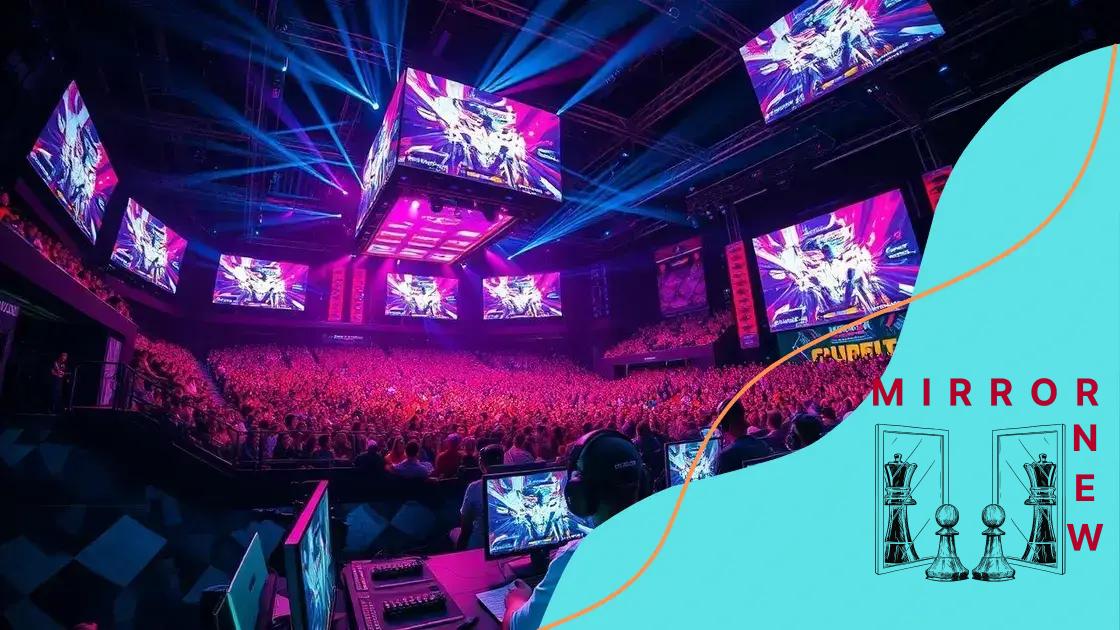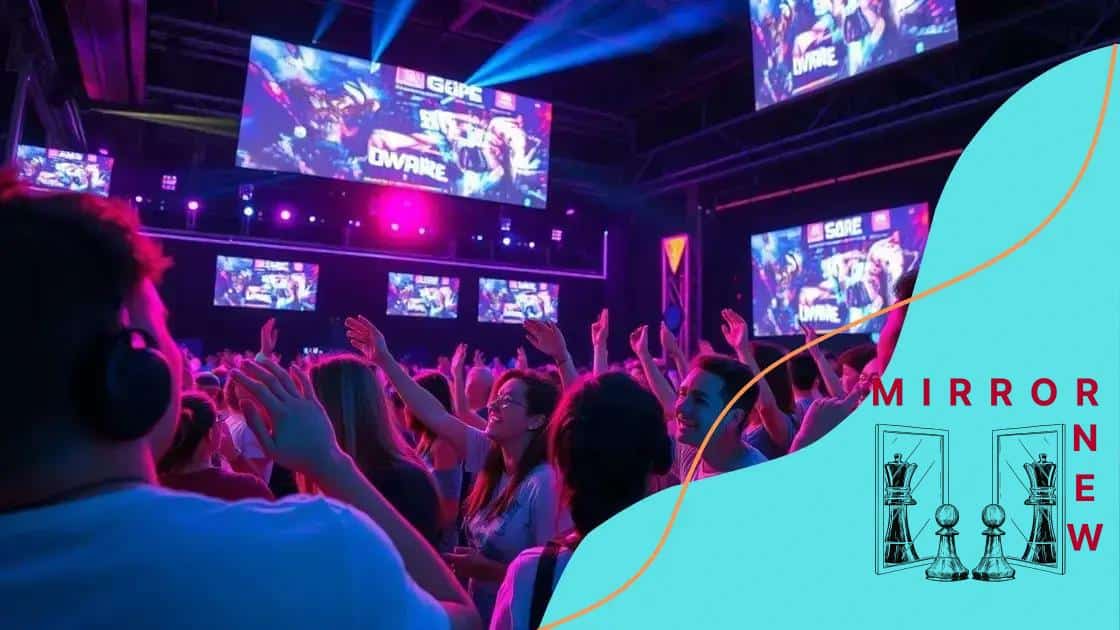How e-sports are influencing mainstream media content

E-sports are significantly influencing mainstream media content by integrating interactive viewing experiences, fostering brand partnerships, and creating innovative engagement strategies that cater to a growing and dedicated audience.
How e-sports are influencing mainstream media content is a captivating topic that’s reshaping the entertainment landscape. Have you noticed how gaming tournaments have become media spectacles? Let’s dive into this world!
The rise of e-sports: An overview
The rise of e-sports has transformed the gaming landscape, creating a vibrant competitive scene that attracts millions. More than just a hobby, e-sports is now a global phenomenon with dedicated fans, sponsorships, and professional leagues.
What are e-sports?
E-sports refers to organized video game competitions, particularly between professional players or teams. Games like League of Legends, Dota 2, and Counter-Strike have become household names, with events filling massive arenas.
Key Factors in E-sports Growth
Several factors have contributed to the explosion of e-sports:
- Advancements in technology that enhance gaming experiences.
- The rise of streaming platforms like Twitch, allowing fans to watch live competition.
- A growing cultural acceptance of gaming as a legitimate career.
As e-sports continues to evolve, its impact stretches beyond just gaming. It’s influencing marketing strategies and entertainment choices across various platforms. Brands are now more involved, using e-sports events as prime opportunities for advertising.
Professional players have begun to garner celebrity status, with many young people looking up to them as role models. This shift is showing how e-sports is changing the perception of gamers in society.
The Future of E-sports
Looking ahead, the future of e-sports seems bright. With increased investment, there are expectations for even larger tournaments and more diverse games. Additionally, educational institutions are now offering scholarships for e-sports athletes. This integration into mainstream media and academia signifies a promising direction.
How e-sports affect traditional media
The impact of e-sports on traditional media is profound and multifaceted. As gaming rises in popularity, conventional media outlets are adapting to this new trend. One notable change is how networks are incorporating e-sports content into their schedules.
Increased Viewership
Many fans are choosing to watch e-sports over traditional sports, which is shifting viewership patterns. Major networks, recognizing this change, now broadcast e-sports tournaments to attract younger audiences. With high-energy action, these events captivate millions, proving that competitive gaming can rival traditional sports.
Content Collaboration
Another way e-sports influence traditional media is through collaborations. Media companies partner with e-sports organizations to produce specialized content. This collaboration helps in:
- Creating documentaries about players and their journeys.
- Featuring behind-the-scenes looks at e-sports events.
- Offering live commentary and analysis of matches.
This merger not only enriches content but also builds a bridge between traditional and digital audiences. As e-sports continues to grow, traditional media must evolve or risk losing relevance.
Furthermore, advertising strategies are also changing. Brands are increasingly targeting the e-sports audience through digital platforms. This shift means companies are investing in gaming-related ads, which appeals directly to this demographic, providing personalized marketing strategies that engage fans effectively.
The Future of Media
As we look to the future, it is clear that e-sports will continue to shape the landscape of traditional media. We can expect more integration of gaming into mainstream broadcasts and innovative formats to capture audience interest. This evolution highlights the necessity for traditional media to adapt to the changing preferences of viewers.
Viewer engagement through e-sports

Viewer engagement in e-sports has reached new heights, creating a vibrant community of fans who actively participate in the gaming scene. Unlike traditional sports, e-sports offers unique ways for viewers to connect with their favorite games and players.
Interactive Experiences
One key factor in enhancing viewer engagement is the level of interactivity offered by e-sports. Fans can:
- Join live chats during streams, sharing their thoughts and reactions.
- Participate in polls and votes that influence in-game decisions.
- Cheer for their favorite teams in real-time, fostering a sense of community.
This interactivity allows fans to feel part of the action, making each viewing experience more immersive and enjoyable.
Community Building
As e-sports grows, so do fan communities. Online platforms and social media have made it easier for fans to connect with others who share their interests. Communities emerge around:
- Specific games, where players discuss strategies and share content.
- Individual teams or players, creating dedicated fanbases.
- Events, where fans gather to celebrate their favorite competitions.
This sense of belonging enhances viewer engagement, as fans want to be part of larger events and discussions about e-sports.
Additionally, platforms like Twitch allow fans to interact directly with streamers. This personal connection encourages fans to return, building loyalty and boosting viewership. Streamers often engage with their audience by responding to comments and hosting Q&A sessions.
Innovative Content Formats
Moreover, innovative content formats keep fans excited. From action-packed highlight reels to in-depth analysis, e-sports offer diverse content that appeals to various interests. Creative formats include:
- Live commentary during games, adding excitement.
- Behind-the-scenes looks at teams and events.
- Interviews with players to share personal stories.
This variety ensures that every fan finds something that resonates, further enhancing their connection to the e-sports world.
Sponsorship and advertising shifts
The landscape of sponsorship and advertising in e-sports has evolved rapidly. As viewership increases, brands recognize the value of connecting with e-sports audiences. Companies are investing in sponsorship deals, leading to new marketing strategies targeted at gamers.
Rise of Brand Partnerships
Many brands are forming partnerships directly with e-sports teams and events. This approach allows companies to reach specific demographics. For example, brands like Red Bull and Adidas have sponsored major leagues and tournaments.
- Collaborations help brands reach fans where they are most engaged.
- Sponsorships often include logo placements during live streams.
- Brands create exclusive content featuring popular players.
These partnerships not only boost brand visibility but also enhance the gaming experience for fans.
Innovative Advertising Methods
In addition to traditional advertisements, e-sports introduces innovative marketing techniques. Here are a few notable examples:
- In-game advertising that blends seamlessly with gameplay.
- Integrated brand challenges, encouraging player participation.
- Custom merchandise featuring both the game and the sponsor.
These methods engage audiences without disrupting their viewing experience. Fans appreciate how brands enhance their involvement with e-sports culture.
Moreover, digital platforms have changed how ads are delivered. Streaming services allow brands to create targeted ads based on viewer behavior. This method maximizes impact and increases ROI for sponsors. Understanding the community and their preferences is crucial for success.
The Future of Sponsorship
Looking ahead, the future of sponsorship in e-sports appears promising. As the industry grows, more companies are likely to explore partnerships. The rise of mobile gaming and accessibility will also draw more brands. Responsiveness to fan interactions will help refine advertising strategies.
The future of media in the e-sports era
The future of media in the e-sports era looks promising as technology and viewing habits evolve. As gaming continues to gain popularity, media outlets are adapting to meet the demands of this new audience.
Emergence of New Broadcasting Platforms
Streaming services have changed how we consume content. Platforms like Twitch and YouTube Gaming provide dedicated spaces for e-sports. Viewers can watch live tournaments, engage with chat, and follow their favorite players. These platforms create opportunities for:
- Interactive viewing experiences that enhance fan engagement.
- Real-time reactions and instant feedback during streams.
- Diverse content types, including tutorials and game highlights.
As more people turn to these platforms, traditional media must innovate to compete.
Integration of Virtual Reality (VR)
Virtual reality is poised to revolutionize how fans experience e-sports. With VR technology, viewers can feel as though they are part of the action. This immersive experience can lead to:
- New locations for virtual audiences, enhancing the event atmosphere.
- Interactive elements where viewers can influence gameplay.
- Enhanced storytelling, allowing fans to connect with players’ journeys.
Adopting VR will require investment but has the potential to attract more audiences.
Growth of Esports Journalism
As e-sports gains traction, journalism focused on the gaming sector will expand. Coverage of tournaments, player interviews, and in-depth analysis will become more common. Fans will seek content that highlights:
- Player performances and achievements.
- Industry trends and news.
- Behind-the-scenes looks at teams and events.
This journalism will cater to an audience hungry for rich content and analysis in the e-sports world.
As we look ahead, it’s clear that media must adapt to the preferences of younger viewers. Integrated advertising, cross-platform content, and community involvement will shape the success of e-sports in the media landscape.
FAQ – Frequently Asked Questions about E-sports and Media
How are e-sports changing traditional media?
E-sports are reshaping traditional media by introducing new streaming platforms and content formats that attract younger audiences.
What role do brands play in e-sports?
Brands are forming partnerships with e-sports teams and events, allowing them to reach targeted demographics and engage fans through innovative advertising.
How do viewers engage with e-sports content?
Viewers engage through live chat, social media interaction, and immersive experiences such as virtual reality, enhancing their connection to the gaming culture.
What is the future of e-sports in the media landscape?
The future of e-sports in media looks bright, with ongoing growth in viewership, increased integration of technology, and a focus on community engagement.





